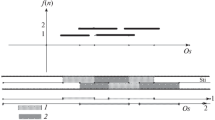Abstract
We present a parallel architecture for object recognition and location based on concurrent processing of depth and intensity image data. Parallel algorithms for curvature computation and segmentation of depth data into planar or curved surface patches, and edge detection and segmentation of intensity data into extended linear features, are described. Using this feature data in comparison with a CAD model, objects can be located in either depth or intensity images by a parallel pose clustering algorithm.
The architecture is based on cooperating stages for low/intermediate level processing and for high level matching. Here, we discuss the use of individual components for depth and intensity data, and their realisation and integration within each parallel stage. We then present an analysis of the performance of each component, and of the system as a whole, demonstrating good parallel execution from raw image data to final pose.
Similar content being viewed by others
References
W.J. Austin and A.M. Wallace. Recognition and location by parallel pose clustering. In Proc. of 6th British Machine Vision Conference, pages 661–670, 1995.
P.J. Besl and R.C. Jain. Invariant surface characteristics for 3d object recognition in range images. Computer Vision, Graphics and Image Processing, 33:33–80, 1986.
J. F. Canny. A computational approach to edge detection. IEEE Trans. PAMI, 8(6):679–698, 1987.
V Chaudhary and J.K. Aggarwal. Parallelism in computer vision: A review. In V. P. Kumar, P. S. Gopalakrishnan, and L. N. Kanal, editors, Parallel Algorithms for Machine Intelligence and Vision. Springer-Verlag, 1990.
J Clark, G Zhang, and A.M. Wallace. Image acquisition using fixed and variable triangulation. In Proc. of IEE Int. Conf on Image Processing, pages 539–543, 1995.
M. I. Cole. Algorithmic skeletons: structured management of parallel computation. Pitman, 1989.
M.A. Fischler and R.C. Bolles. The random sample consensus set: a paradigm for model fitting with applications to image analysis and automated cartography. Communications of the ACM, 24(6):381–395, 1981.
V. Leavers. Which Hough transform. CVGIP: Image Understanding, 58(2):250–264, 1993.
G.J. Michaelson and N. Scaife. Prototyping a parallel vision system in Standard ML. Journal of Functional Programming, 5(3):345–382, 1995.
M. Rygol, S.B. Pollard, and C.R. Brown. MARVIN and TINA: A multiprocessor 3d vision system. Concurrency: Practice and Experience, 34(4):333–356, 1991.
M. Rygol, S.B. Pollard, and C.R. Brown. Multiprocessor 3d vision system for pick and place. Image and Vision Computing, 9(1):33–38, 1991.
G. Stockmann. Object recognition and localization via pose clustering. Computer Vision, Graphics and Image Processing, 40:361–387, 1987.
E. Thirion and A.M. Wallace. Compilation and sufficient representation of object models for visual recognition. Pattern Recognition Letters, 13:797–803, 1992.
R. Y. Tsai. A versatile camera calibration technique for high accuracy 3d machine vision metrology using off-the-shelf TV cameras and lenses. IEEE Trans. on Robotics and Automation, 3(4):323–344, 1987.
A.M. Wallace, G.J. Michaelson, P. McAndrew, K. Waugh, and W. Austin. Dynamic control and prototyping of parallel algorithms for intermediate and high level vision. IEEE Computer, 25(2):43–53, February, 1992.
C-L. Wang, P.B. Bhat, and V.K. Prasanna. High performance computing for vision. Proceedings of the IEEE, 84(7):931–945, 1996.
H. Wang and M. Brady. PARADOX — a heterogeneous machine for the 3d vision algorithm. Concurrency: Practice and Experience, 7(4):257–272, 1995.
C.C. Weems, S.P. Levitan, A.R. Hanson, E.M. Riseman, D.B. Shu, and G. Nash. The image understanding architecture. International Journal of Computer Vision, 2:251–282, 1989.
S. Yalamanchili and J.K. Aggarwal. Parallel processing methodologies for image processing and computer vision. Advances in Electronics and Electron Physics, 87:259–299, 1994.
Author information
Authors and Affiliations
Rights and permissions
About this article
Cite this article
Wallace, A., Michaelson, G., Scaife, N. et al. A Dual Source, Parallel Architecture for Computer Vision. The Journal of Supercomputing 12, 37–56 (1998). https://doi.org/10.1023/A:1007925309764
Issue Date:
DOI: https://doi.org/10.1023/A:1007925309764




